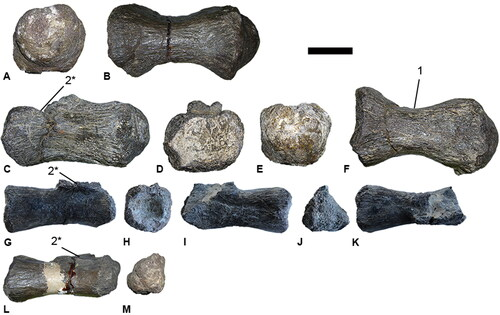Uriash
- unexpecteddinolesson
- Feb 20
- 3 min read
Updated: Feb 21
MEANING: Uriaș
PERIOD: Late Cretaceous
CONTINENT: Europe
Uriash is a European titanosaur with evolutionary affinities to those from the southern continent of Gondwana. Its discovery strengthened the hypothesis that titanosaurs spread from the south in the Early Cretaceous. Small for a titanosaur, Uriash is one of the largest known from the European archipelago at about 10 m in length, and weighing 5-8 t in body mass.

Abstract from paper: The Hațeg Basin and surrounding areas in Transylvania, western Romania, have been a hotspot for research on vertebrate faunas of the Late Cretaceous European Archipelago. One of the historically earliest titanosaurian sauropod dinosaurs to be discovered, the ‘dwarfed’ species Magyarosaurus dacus comes from lower Maastrichtian deposits in this basin; however, this species has been neglected, with no modern treatment of its anatomy, taxonomy or phylogenetic affinities. Via detailed anatomical study of historical and undescribed remains, combined with archival data, we identify shared autapomorphies that link multiple partial skeletons. Our analysis of hundreds of specimens (including >20 monospecific assemblages) enables the stabilization of the type species Magyarosaurus dacus. We propose the presence of three additional, but only partly contemporaneous taxa – Paludititan nalatzensis, Petrustitan (‘Magyarosaurus’) hungaricus n. gen. and Uriash kadici n. gen. n. sp. (the latter being amongst the largest known sauropods of the Late Cretaceous European Archipelago). We present a new phylogenetic analysis (152 taxa scored for 570 characters), with implications for broader titanosaurian evolutionary relationships and biogeography: Magyarosaurus is recovered either as a member or a close relative of Saltasauridae; Paludititan has affinities with Lognkosauria, along with the contemporaneous Lohuecotitan; Petrustitan is most closely related to South American early diverging eutitanosaurian taxa; and Uriash also shares affinities with Gondwanan taxa. Our findings strengthen the hypothesis that latest Cretaceous European titanosaurs belonged to Gondwanan lineages that invaded the former area during the Barremian–Albian. We interpret the presence of body-size disparity as either evidence that large-bodied taxa were ecologically excluded from body-size reduction by competition with small-bodied titanosaurs, or that dwarfing occurred stratigraphically earlier among several lineages and the small-bodied titanosaurs on Hațeg Island are the descendants of existing dwarfed ancestors. Finally, we find no indication of a body size-related titanosaurian turnover in the uppermost Cretaceous of the Transylvanian area.
Uriash is from the Cretaceous. The Cretaceous is a geological period that lasted from about 145 to 66 million years ago. It is the third and final period of the Mesozoic Era, as well as the longest. At around 79 million years, it is the longest geological period of the entire Phanerozoic. The name is derived from the Latin creta, "chalk", which is abundant in the latter half of the period.
The Cretaceous was a period with a relatively warm climate, resulting in high eustatic sea levels that created numerous shallow inland seas. These oceans and seas were populated with now-extinct flora and fauna, while dinosaurs continued to dominate on land. The world was ice free, and forests extended to the poles. During this time, new groups of mammals and birds appeared. During the Early Cretaceous, flowering plants appeared and began to rapidly diversify, becoming the dominant group of plants across the Earth by the end of the Cretaceous, coincident with the decline and extinction of previously widespread gymnosperm groups.
The Cretaceous (along with the Mesozoic) ended with the Cretaceous–Paleogene extinction event, a large mass extinction in which many groups, including non-avian dinosaurs, pterosaurs, and large marine reptiles, died out. The end of the Cretaceous is defined by the abrupt Cretaceous–Paleogene boundary (K–Pg boundary), a geologic signature associated with the mass extinction that lies between the Mesozoic and Cenozoic Eras.
Uriash is a sauropod. Sauropods are saurischian dinosaurs that had very long necks, long tails, small heads (relative to the rest of their body), and four thick, pillar-like legs. They are notable for the enormous sizes attained by some species, and the group includes the largest animals to have ever lived on land. Well-known genera include Brachiosaurus, Diplodocus, Apatosaurus and Brontosaurus.
The oldest known unequivocal sauropod dinosaurs are known from the Early Jurassic, and by the Late Jurassic (150 million years ago), sauropods had become widespread. By the Late Cretaceous, one group of sauropods, the titanosaurs, had replaced all others and had a near-global distribution. This group included the largest animals ever to walk the earth. Estimates vary, but the largest titanosaurs are estimated at upward of around 40 m, and weighing 100 t, or possibly even more.
As with all other non-avian dinosaurs alive at the time, the titanosaurs died out in the Cretaceous–Paleogene extinction event. Fossilized remains of sauropods have been found on every continent, including Antarctica.












